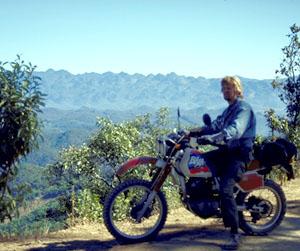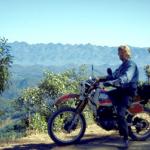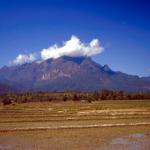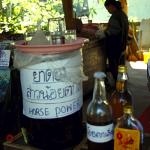Baja Tracks in the Jungle
We just had to pull over for a breather and a much-needed stretch but there was no level ground in sight. It wasn't really possible to stop moving at all, even for a split second - at least not without applying full and constant pressure to both brakes. As we wrestled around yet another blind corner I caught sight of a patch of flat ground and hit the pedal. The back wheel responded with a slide, spitting gravel from the tread as it came to a standstill. Now free from the intense concentration required to keep the bike upright as we moved at speed across the violent terrain, release came in the form of a singularly appropriate word, 'Unbelievable'.
Much to our surprise the silence that had fallen on the forest when our engine died was soon broken by the unexpected sound of another motorcycle approaching us from above. Pulling along side and lifting up his goggles he spoke.
'German?'
'English', came the curt response. Immediately acknowledging the language barrier he resorted to animation to convey his message. Puffing up his cheeks and shaking his head whilst blowing out air, he rolled his hand up and down like a small child describing a stormy sea. With that, wide - eyed and weary he continued down the troublesome slope. We knew it was going to get rough.
Which, of course, is exactly why we were there. For some there is no finer thrill than tearing along a road that resembles a battlefield. But the road wears its scars well and in capable hands our Honda Baja 250 responds like an attentive nursemaid - gentle when desired, forceful when necessary. There is no better way to gain access to the heart of Thailand. Folds of grey asphalt seem to flow effortlessly down from the mountains responding to every obstacle with an elegant curve or challenging hairpin. Connected to these is a maze of red dirt track arteries etched into the surface - enough to mock even the most skilled cartographer.
The journey began in Chiang Mai heading out towards Chiang Dao on route 107. Upon arrival we resisted the opportunity to explore the depths of the famous cave, as our goal was clearly set. Prowling around at low speed, the motor barely ticking over, we kept our eyes peeled for a turning that would lead us away from the submissive tarmac to more tenacious surface rising up behind the chiseled features of Doi Chiang Dao - Thailand's second highest peak. And rise it did - at quite an alarming rate. The crudely cut line, defended by sentry-like trees and looming towers of bamboo, snaked it's way up the mountain ready to bite if we made a false move. Immediately challenged, the rider has to contend with the trails history, which it makes no effort to conceal. The season's torrential rains had eaten away at the surface, cutting deep clefts and gullies into the sandstone and clay. Concentration is of paramount importance when traveling over such demanding terrain, as is the ability to read and respond to the ever-changing conditions. Dry in open areas, soft and wet in the shadow of tight bends, exposed roots, rocks and loose gravel, pot holes hidden by fallen leaves, sheer drops one side then the other - all are possible in the space of half a kilometre. The route leads you on a merry dance through the mountainous landscape but dance to its tune and you'll be viewing the glorious scenery from ground level.
Our intention was to reach the village of Muang Khong some 40 kilometres further on and hopefully find somewhere to rest for the night. It was strange to think when crossing such grueling ground that people actually lived somewhere along this road. The fact is though, despite the seeming remoteness of the area, you are never very far from habitation. Every now and again the ubiquitous Toyota pickup truck - with half a dozen villagers and a motorcycle in the back - will struggle past. An odd reminder that what we consider action and adventure is just part of everyday life for others. Occasionally an unmarked trail breaks off the main route and dives down into a valley, twisting its way to one of many Hill Tribe villages in the area. These side trails can be extremely formidable, if not downright dangerous, even on an off-road bike - as we were soon to discover. Heading down to a Lisu village the gradient was so severe and the bends so tight that the descent caused my pillion passenger and I to slide forward uncontrollably. I found myself on the tank, knees gripping tightly, hand and arms straining to keep us from moving further forward. During the wet season villages at the end of such roads can remain cut off for months. An ascent, even in favourable conditions, is testing and on our return there were times during which the Baja could not climb the sandy surface with two of us on the bike.
After riding along the ridge of the mountain for some distance the trail suddenly began it's descent. Riding through several streams that crossed the path proved to be a refreshing and entertaining distraction. At a lower altitude small stepped rice fields cut into the hillsides started to appear along with the occasional wandering dog - a sure sign that a village is near by - then simple houses constructed of bamboo and thatch. It turned out to be Ban Pa Sow, ten kilometres short of our destination, but it looked friendly and inviting so we decided to stop and talk with the locals. They were Karen, one of the larger minority groups in the north. As is often the case with Hill Tribe villages the poverty was arresting yet the hospitality warm and welcoming and we were soon offered a bed for the night. Many such places have no electricity or running water so after bathing in the stream we sat down to a simple meal of eggs and rice, washed down with rice whisky and tea. Huddled around a small fire to keep the damp evening air at bay we sat and talked about village life. Attempts to find out what lay in wait at the next village failed as nobody had actually been there. Quite a startling revelation when you consider how close it was. As darkness fell we retired to the bamboo house of our host, sufficiently warmed by the whisky, and slept soundly.
Jubilant roosters welcomed daybreak, their calls resonating under the stilted house and stirring us to life. The Baja, however, was not so keen to rise. The damp mountain air meant that it needed a few too many kicks before it's rasping sound disturbed the slumbering village. Local women dressed in traditional clothes gathered round and watched as I struggled with the technology that they seemed to have little use for. Back on the road the contrast between our peaceful evening by the fire and chaos of the trail couldn't have been more absolute. Full attention was instantly demanded and the need for my early morning coffee diminished as were jolted and jarred by the stony ground. Misjudging the depth of the first stream of the day resulted in an unwelcome dip and boots full of icy water. Arriving at Muang Khong we filled up with petrol and refueled ourselves with a light breakfast. The village was pleasant enough but has little to offer so we decided to continue on in the direction of Wiang Haeng. This section of the trip promised to be the most rigorous as it was marked on the map as a path. Once we had found the track it soon started to narrow, the forest closing in on all sides. Every now and again a tree lurched hopelessly across the path its roots some how resisting total collapse. Such obstacles would cause us to dismount and push the underneath. We rode up rivers, around fallen trees and over bamboo. The whole experience was exhilarating. Intense enjoyment coupled with the nagging fear of a possible break down in the jungle. Slight paranoia had me questioning Japanese reliability and my own sanity for attempting such a jaunt. Yet riding down a riverbank so steep that there really was 'no turning back' was oddly liberating and such thoughts seemed to dissipate. A chance meeting with a Hill Tribe villager with a basket on her back and who did not understand Thai added to the sense of adventure and discovery. The concept of time altered too. When we met another forest dweller and asked how far it was to the next village he replied 'A mornings walk.' It was at this point that I realised that we had truly entered another world yet were merely traveling through it at speed, snatching moments and memories out of the air in passing.
The Lisu village of Huai Ya Sai was our next rest stop but first we had to cross a major river. On a sand bar women washed clothes and children bathed as men caught fish - it was a heart-warming sight and we stopped to chat a while. The river was deep enough to cause my partner to cross, arms outstretched, via a fallen tree as I charged the bike through and emerged on the other side engulfed in a cloud of steam from the rapidly cooling engine. Sitting down to dry in the afternoon sun gave the Baja a well-earned rest. It had performed well, and although a little extra power would be welcome for the steep inclines, it's a nimble machine and easy to handle even with my partner and a pack on board.
It had been a phenomenal days riding - undoubtedly the best that I'd ever had - yet the off-road experience was far from over. The next day we rode up a mountain track towards Muang Noi and our next resting point, the town of Pai. The riding was as arduous as ever and at times the concentration so intense that it's exhausting. Yet there came a point on this section where the task at hand seemed to become almost effortless. It was certainly odd, as the road was no more exacting than before. My movements seemed to flow and become almost dream-like and I knew that I could not make a false move. It probably sounds asinine to suggest it but I felt such a connection between the bike and myself - almost as if we had, for a time, become one. Of course, as with all moments of a transcendental nature, it was fleeting.
The sleeping beauty of Muang Noi interrupted the demands and disorder of the trail; a Karen village nudged up against a babbling brook and nestled in the mountains above the Pai valley, it's charms impossible to resist. The last of the off-road riding was a 30 kilometre stretch up and along the mountain ridge, giving spectacular views of the valley below and peaks that roll on as far as the eye can see. The descent here is steep and, with a loose sand and gravel surface, treacherous. Again it calls for skill and concentration. Saddle sore and dust covered we rode triumphantly into Pai anticipating two days well earned rest - and a couple of short excursions into the hills of course - before heading back to Chiang Mai.
This section of great tarmac is part of a loop that in a distance of a few hundred kilometres boasts 2000 bends. Outrageous curves flow into hairpin after hairpin and all set against stunning scenery. What goes up must come down...then go up again...and down...and sharply left and right. It's a bikers dream circuit and it was on such road that we twisted and turned our way back to Chiang Mai. As we followed the winding route down from the mountains I felt in need of a breather and a good stretch but had no intention of pulling over. I was going to savour every second - right up to the city limits.
* * * * *
Reality Check Point
There are hundreds of dirt tracks and miles of great asphalt in the region. Organised biking trips are available through a couple of companies but they are by no means necessary. Bike hire is easy and cheap in Chiang Mai - about tenner for 24 hours. As nothing over 150cc is built in Thailand most hire bikes are imported second hand from Japan. The most readily available are Honda Baja 250's. For those who want to stay on the main roads or just do a bit of light off-road work the water cooled Honda AX1 250 is the best bet. Exercise caution when hiring - check the bikes over thoroughly as not all hirers are reliable. Dang's Bike Hire is good for AX1's and should you break down they will come and get you or bring a replacement bike.
Plan your trip well. Do not attempt to go off-road here unless you have a realistic view of your ability both as a rider and a mechanic. Fill up at every available opportunity and carry plenty of water. Riding off-road alone is not advised. The terrain is testing and a breakdown could find you in a very sticky situation.
A couple of decent guides are available here namely A Motorcycle Guide to the Golden Triangle and The Mae Hong Song Loop, both by Chiang Mai based David Unkovich. A good source of information is David's website.The best map is Thailand North by Brendtson and Brendtson.
The best time to ride here is during the cool season - November till early February. The hot season is unbearable and the rainy season makes dirt tracks impassable. Last but not least please make the effort to learn a little about the culture before you come - especially that of the Hill Tribes.
* * * * *
 ThingsAsian
ThingsAsian




















